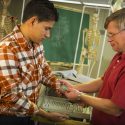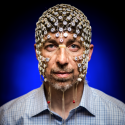Grad program honored for closing science-society gap
A graduate researcher in the Neuroscience and Public Policy Program works in a lab at University Research Park.
The University of Wisconsin–Madison’s Neuroscience and Public Policy Program was recently honored by the Society for Neuroscience with the Neuroscience Graduate Program Achievement Award.
Ron Kalil — a neuroscientist, professor of ophthalmology and visual sciences and director of the Neuroscience and Public Policy Program — accepted the award Sunday in Washington, D.C., at the society’s annual meeting.
“It’s gratifying that the work our students and faculty have done since the program was established in 2005 will be recognized this way,” Kalil says. “They have a lot to be proud of.”
The UW–Madison program was honored as this year’s top graduate program in neuroscience in the country. The University of Washington’s neurobiology program took the undergraduate honors.
“How do you get policymakers to consider science, to take the best of what we know into account, when they’re trying to make the world better through government and laws?”
Ron Kalil
The UW–Madison program has added two or three students a year since 2005, expanding from one track on neuroscience and public policy to include a specialization in international policy and another in neuroscience and the law.
Each student earns a doctorate in neuroscience alongside a master’s degree in international affairs or public affairs from the La Follette School of Public Affairs or a Juris Doctor from UW–Madison’s School of Law.
“These days, when we look at students, we’re considering people who are already trying to do things we can help them accomplish,” Kalil says.
One recent student entered the UW–Madison graduate program after serving as scientific ambassador to the community around the college where she earned her undergraduate degree. Another spent time consulting on psychology issues with a national magazine. A third had been trying to engage policy makers in science discussions since high school.
Sometimes, the worlds of science and public policy seem to occupy different planets. That’s where graduates of programs like UW–Madison’s can help.
“There is a wide gap between science and society in general. Taken as a whole, scientists have done a poor job describing the way they think and work,” Kalil says. “So we have a big problem: How do you get policymakers to consider science, to take the best of what we know into account, when they’re trying to make the world better through government and laws?”
“Whenever we can find a way to close the gap between the science and the people who can put it to use, society benefits.”
Ron Kalil
By training people to be both good scientists and effective advocates.
With the help from the Kavli Foundation, the Neuroscience and Public Policy Program brings to campus examples of success in both spheres — like biochemist and former National Academy of Sciences President Bruce Alberts and psychologist Alan Leshner, chief executive officer of the American Association for the Advancement of Science (AAAS).
The program also works to give members of the scientific community and policy community a window into the other camp. This summer, the program hosted an AAAS workshop for judges in Madison on the state of the science in pain, substance abuse and violence — among other topics.
“These judges are asked to sentence people, but often they don’t know what was going on in the heads of the accused when they did wrong,” Kalil says. “Whenever we can find a way to close the gap between the science and the people who can put it to use, society benefits.”


